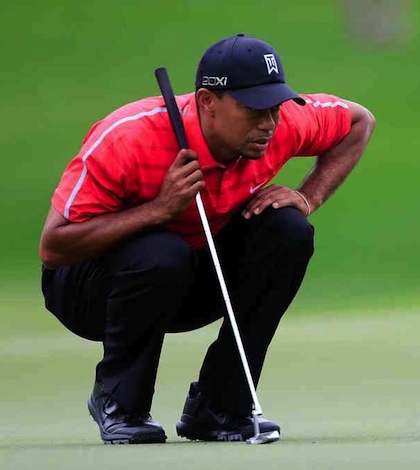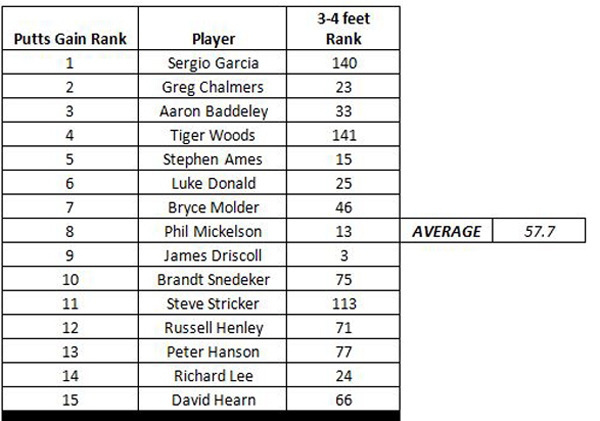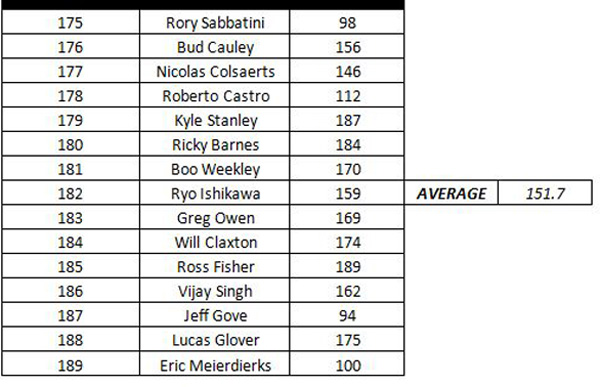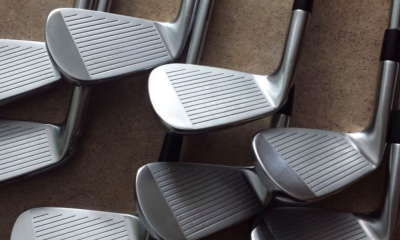Opinion & Analysis
The most important putts to make

Back in May, I felt that Tiger Woods was Statistically Primed For the U.S. Open.
Tiger had just come off his fourth victory for the year, and was using a very conservative tee shot strategy — hitting a lot of 3 woods and 5 woods off tees where most of his competitors were hitting driver.
All of the research I have conducted actually states that a conservative tee shot strategy is usually a bad idea, and that leaving the driver in the bag should be a golfer’s very last option, not his first or second option. But, my reasoning was that since Merion would force a lot of lay-up shots off the tee and that nobody was better at laying up off the tee than Tiger, he was in prime position to win his fourth U.S. Open.
However, there was something that made me a little uncomfortable about forecasting Tiger’s success for the U.S. Open. For most of the first half of the season he was by far and away the best putter on the PGA Tour from outside 15 feet. And all the research I have done has shown that Tour players will move toward the means on putts from outside 15 feet regardless of their putting skill level. I feel that this important information for amateurs to understand in order to not only putt better, but to better plan their shots.
The gold standard for putting metrics is Strokes Gained – Putting. The concept is simple: It calculates the distance of the putt and what the average number of putts for the field have been from that distance. Then it takes the number of putts the golfer makes and subtracts it from the field average.
For example, if a golfer two-putts from 40 feet and the field average from 40 feet for the tournament is at 2.183 strokes, then the golfer gained 0.183 strokes on the field from that particular distance of putt. If the golfer three-putts, then they lost -0.817 strokes to the field on that putt.
What I found was that the distance range of putts that correlates most strongly to Strokes Gained — Putting are putts from 3 to 15 feet. Here is the list of the current top-15 golfers in Strokes Gained — Putting and how they rank on putts from various distances.
The table shows that not only do these top putters tend to rank much better on putts from 3 to 15 feet than on putts longer than 15 feet, but the standard deviation shows much more variance in the rankings as the putts get longer. Sergio Garcia is ranked No. 1 in putts from more than 25 feet and in Strokes — Gained Putting. However, this is merely an anomaly and goes to show how there is little rhyme or reason as to what golfers will make putts from longer than 15 feet.
Here’s a line chart that hopefully illustrates the point a little better.
I call the percentage of putts made from longer than 15 feet a “volatile metric.” What I mean is that a player may rank high in putts made from greater than 15 feet one season, and then rank low on putts made from greater than 15 feet the very next season. It does not matter if the golfer is generally a “great putter” or a “bad putter.”
Here’s a few examples using typically “great putters” (Baddeley, Donald and Snedeker) versus typically “bad putters” (Weekley, Garrigus and Stadler) on putts from longer than 15 feet over the years.
The table further demonstrates the volatility on making putts from longer than 15 feet. Luke Donald has been the greatest putter on Tour during the past five years, and he has had some years where he has made a high percentage of putts from longer than 15 feet and other years where he has struggled from this distance. Conversely, Boo Weekley has been one of the worst putters on Tour in the past five years and he has had some years where he has made a lot of long putts and in other years he has struggled from longer distances.
The data shows that making putts from outside 15 feet has more to do with luck, while making putts from inside 15 has more to do with skill. Thus, for golfers looking to learn from this, they should spend more of their time practicing putts from 3 to 15 feet than putts longer than 15 feet.
However, if I want to go into more finite detail, the strongest correlation of putts made from a one-foot distance range and putts gained is putts from 3 to 4 feet. This is particularly telling when we look at the rankings of the top and bottom-15 players in Strokes Gained — Putting and their rankings in putts from 3 and 4 feet.
I believe that the reason for the strong correlation on these 3- to 4-foot putts and Strokes Gained — Putting is because a putt from 3 to 4 feet is very makeable, but just difficult enough where golfers can easily miss. I believe that these putts require the basic fundamentals to good putting in the golfer’s ability to aim properly, the centeredness of contact and having the right amount of touch and speed on the putt. I also feel it requires a sharp eye for green reading.
While most putts from 3 to 4 feet have little or no break to them, the golfer has to correctly identify that small break when it is there. And again, we should note that Sergio (and Tiger) are mere anomalies as the average ranking for these top-15 putters from 3 to 4 feet is typically in the top-50.
Thus, I recommend golfers not only focus their practice toward putts from inside 15 feet, but to spend a little extra time on those 3 to 4 footers in order to get the fundamentals of putting.
But, that’s not all that the data shows. Another key metric is that current average on Tour is for a golfer to make one birdie putt from outside 15 feet for every 36.2 holes of golf he plays. In essence, it will take a little over two rounds before the average Tour player will make a birdie putt longer than 15 feet.
Thus, if golfers want to make more birdies, they need to strive to get more birdie putts inside 15 feet rather than hope that they can make a few long putts outside of 15 feet. This is what happens in EVERY super-low round on Tour. The player simply accumulates a lot of birdie opportunities. For instance, Tiger’s 61 at Firestone included nine birdie opportunities from inside 15 feet in which Tiger converted eight of them.
For golfers looking to shoot better scores by improving their putting, focus on making more putts from inside 15 feet. And if you’re looking to make substantial improvements to your score, accumulate more birdie opportunities inside 15 feet. For the higher handicappers, I suggest continuing to work on putting from inside 15 feet and to try to accumulate more par opportunities from inside 15 feet.
- LIKE3
- LEGIT0
- WOW0
- LOL0
- IDHT0
- FLOP0
- OB0
- SHANK0
19th Hole
Vincenzi’s 2024 Zurich Classic of New Orleans betting preview

The PGA TOUR heads to New Orleans to play the 2023 Zurich Classic of New Orleans. In a welcome change from the usual stroke play, the Zurich Classic is a team event. On Thursday and Saturday, the teams play best ball, and on Friday and Sunday the teams play alternate shot.
TPC Louisiana is a par 72 that measures 7,425 yards. The course features some short par 4s and plenty of water and bunkers, which makes for a lot of exciting risk/reward scenarios for competitors. Pete Dye designed the course in 2004 specifically for the Zurich Classic, although the event didn’t make its debut until 2007 because of Hurricane Katrina.
Coming off of the Masters and a signature event in consecutive weeks, the field this week is a step down, and understandably so. Many of the world’s top players will be using this time to rest after a busy stretch.
However, there are some interesting teams this season with some stars making surprise appearances in the team event. Some notable teams include Patrick Cantlay and Xander Schauffele, Rory McIlroy and Shane Lowry, Collin Morikawa and Kurt Kitayama, Will Zalatoris and Sahith Theegala as well as a few Canadian teams, Nick Taylor and Adam Hadwin and Taylor Pendrith and Corey Conners.
Past Winners at TPC Louisiana
- 2023: Riley/Hardy (-30)
- 2022: Cantlay/Schauffele (-29)
- 2021: Leishman/Smith (-20)
- 2019: Palmer/Rahm (-26)
- 2018: Horschel/Piercy (-22)
- 2017: Blixt/Smith (-27)
2024 Zurich Classic of New Orleans Picks
Tom Hoge/Maverick McNealy +2500 (DraftKings)
Tom Hoge is coming off of a solid T18 finish at the RBC Heritage and finished T13 at last year’s Zurich Classic alongside Harris English.
This season, Hoge is having one of his best years on Tour in terms of Strokes Gained: Approach. In his last 24 rounds, the only player to top him on the category is Scottie Scheffler. Hoge has been solid on Pete Dye designs, ranking 28th in the field over his past 36 rounds.
McNealy is also having a solid season. He’s finished T6 at the Waste Management Phoenix Open and T9 at the PLAYERS Championship. He recently started working with world renowned swing coach, Butch Harmon, and its seemingly paid dividends in 2024.
Keith Mitchell/Joel Dahmen +4000 (DraftKings)
Keith Mitchell is having a fantastic season, finishing in the top-20 of five of his past seven starts on Tour. Most recently, Mitchell finished T14 at the Valero Texas Open and gained a whopping 6.0 strokes off the tee. He finished 6th at last year’s Zurich Classic.
Joel Dahmen is having a resurgent year and has been dialed in with his irons. He also has a T11 finish at the PLAYERS Championship at TPC Sawgrass which is another Pete Dye track. With Mitchell’s length and Dahmen’s ability to put it close with his short irons, the Mitchell/Dahmen combination will be dangerous this week.
Taylor Moore/Matt NeSmith +6500 (DraftKings)
Taylor Moore has quickly developed into one of the more consistent players on Tour. He’s finished in the top-20 in three of his past four starts, including a very impressive showing at The Masters, finishing T20. He’s also finished T4 at this event in consecutive seasons alongside Matt NeSmith.
NeSmith isn’t having a great 2024, but has seemed to elevate his game in this format. He finished T26 at Pete Dye’s TPC Sawgrass, which gives the 30-year-old something to build off of. NeSmith is also a great putter on Bermudagrass, which could help elevate Moore’s ball striking prowess.
- LIKE6
- LEGIT3
- WOW1
- LOL1
- IDHT0
- FLOP3
- OB1
- SHANK1
19th Hole
Vincenzi’s 2024 LIV Adelaide betting preview: Cam Smith ready for big week down under

After having four of the top twelve players on the leaderboard at The Masters, LIV Golf is set for their fifth event of the season: LIV Adelaide.
For both LIV fans and golf fans in Australia, LIV Adelaide is one of the most anticipated events of the year. With 35,000 people expected to attend each day of the tournament, the Grange Golf Club will be crawling with fans who are passionate about the sport of golf. The 12th hole, better known as “the watering hole”, is sure to have the rowdiest of the fans cheering after a long day of drinking some Leishman Lager.
The Grange Golf Club is a par-72 that measures 6,946 yards. The course features minimal resistance, as golfers went extremely low last season. In 2023, Talor Gooch shot consecutive rounds of 62 on Thursday and Friday, giving himself a gigantic cushion heading into championship Sunday. Things got tight for a while, but in the end, the Oklahoma State product was able to hold off The Crushers’ Anirban Lahiri for a three-shot victory.
The Four Aces won the team competition with the Range Goats finishing second.
*All Images Courtesy of LIV Golf*
Past Winners at LIV Adelaide
- 2023: Talor Gooch (-19)
Stat Leaders Through LIV Miami
Green in Regulation
- Richard Bland
- Jon Rahm
- Paul Casey
Fairways Hit
- Abraham Ancer
- Graeme McDowell
- Henrik Stenson
Driving Distance
- Bryson DeChambeau
- Joaquin Niemann
- Dean Burmester
Putting
- Cameron Smith
- Louis Oosthuizen
- Matt Jones
2024 LIV Adelaide Picks
Cameron Smith +1400 (DraftKings)
When I pulled up the odds for LIV Adelaide, I was more than a little surprised to see multiple golfers listed ahead of Cameron Smith on the betting board. A few starts ago, Cam finished runner-up at LIV Hong Kong, which is a golf course that absolutely suits his eye. Augusta National in another course that Smith could roll out of bed and finish in the top-ten at, and he did so two weeks ago at The Masters, finishing T6.
At Augusta, he gained strokes on the field on approach, off the tee (slightly), and of course, around the green and putting. Smith able to get in the mix at a major championship despite coming into the week feeling under the weather tells me that his game is once again rounding into form.
The Grange Golf Club is another course that undoubtedly suits the Australian. Smith is obviously incredibly comfortable playing in front of the Aussie faithful and has won three Australian PGA Championship’s. The course is very short and will allow Smith to play conservative off the tee, mitigating his most glaring weakness. With birdies available all over the golf course, there’s a chance the event turns into a putting contest, and there’s no one on the planet I’d rather have in one of those than Cam Smith.

Louis Oosthuizen +2200 (DraftKings)
Louis Oosthuizen has simply been one of the best players on LIV in the 2024 seas0n. The South African has finished in the top-10 on the LIV leaderboard in three of his five starts, with his best coming in Jeddah, where he finished T2. Perhaps more impressively, Oosthuizen finished T7 at LIV Miami, which took place at Doral’s “Blue Monster”, an absolutely massive golf course. Given that Louis is on the shorter side in terms of distance off the tee, his ability to play well in Miami shows how dialed he is with the irons this season.
In addition to the LIV finishes, Oosthuizen won back-to-back starts on the DP World Tour in December at the Alfred Dunhill Championship and the Mauritus Open. He also finished runner-up at the end of February in the International Series Oman. The 41-year-old has been one of the most consistent performers of 2024, regardless of tour.
For the season, Louis ranks 4th on LIV in birdies made, T9 in fairways hit and first in putting. He ranks 32nd in driving distance, but that won’t be an issue at this short course. Last season, he finished T11 at the event, but was in decent position going into the final round but fell back after shooting 70 while the rest of the field went low. This season, Oosthuizen comes into the event in peak form, and the course should be a perfect fit for his smooth swing and hot putter this week.

- LIKE12
- LEGIT3
- WOW0
- LOL1
- IDHT0
- FLOP1
- OB1
- SHANK1
Opinion & Analysis
The Wedge Guy: What really makes a wedge work? Part 1

Of all the clubs in our bags, wedges are almost always the simplest in construction and, therefore, the easiest to analyze what might make one work differently from another if you know what to look for.
Wedges are a lot less mysterious than drivers, of course, as the major brands are working with a lot of “pixie dust” inside these modern marvels. That’s carrying over more to irons now, with so many new models featuring internal multi-material technologies, and almost all of them having a “badge” or insert in the back to allow more complex graphics while hiding the actual distribution of mass.
But when it comes to wedges, most on the market today are still single pieces of molded steel, either cast or forged into that shape. So, if you look closely at where the mass is distributed, it’s pretty clear how that wedge is going to perform.
To start, because of their wider soles, the majority of the mass of almost any wedge is along the bottom third of the clubhead. So, the best wedge shots are always those hit between the 2nd and 5th grooves so that more mass is directly behind that impact. Elite tour professionals practice incessantly to learn to do that consistently, wearing out a spot about the size of a penny right there. If impact moves higher than that, the face is dramatically thinner, so smash factor is compromised significantly, which reduces the overall distance the ball will fly.
Every one of us, tour players included, knows that maddening shot that we feel a bit high on the face and it doesn’t go anywhere, it’s not your fault.
If your wedges show a wear pattern the size of a silver dollar, and centered above the 3rd or 4th groove, you are not getting anywhere near the same performance from shot to shot. Robot testing proves impact even two to three grooves higher in the face can cause distance loss of up to 35 to 55 feet with modern ‘tour design’ wedges.
In addition, as impact moves above the center of mass, the golf club principle of gear effect causes the ball to fly higher with less spin. Think of modern drivers for a minute. The “holy grail” of driving is high launch and low spin, and the driver engineers are pulling out all stops to get the mass as low in the clubhead as possible to optimize this combination.
Where is all the mass in your wedges? Low. So, disregarding the higher lofts, wedges “want” to launch the ball high with low spin – exactly the opposite of what good wedge play requires penetrating ball flight with high spin.
While almost all major brand wedges have begun putting a tiny bit more thickness in the top portion of the clubhead, conventional and modern ‘tour design’ wedges perform pretty much like they always have. Elite players learn to hit those crisp, spinny penetrating wedge shots by spending lots of practice time learning to consistently make contact low in the face.
So, what about grooves and face texture?
Grooves on any club can only do so much, and no one has any material advantage here. The USGA tightly defines what we manufacturers can do with grooves and face texture, and modern manufacturing techniques allow all of us to push those limits ever closer. And we all do. End of story.
Then there’s the topic of bounce and grinds, the most complex and confusing part of the wedge formula. Many top brands offer a complex array of sole configurations, all of them admittedly specialized to a particular kind of lie or turf conditions, and/or a particular divot pattern.
But if you don’t play the same turf all the time, and make the same size divot on every swing, how would you ever figure this out?
The only way is to take any wedge you are considering and play it a few rounds, hitting all the shots you face and observing the results. There’s simply no other way.
So, hopefully this will inspire a lively conversation in our comments section, and I’ll chime in to answer any questions you might have.
And next week, I’ll dive into the rest of the wedge formula. Yes, shafts, grips and specifications are essential, too.
- LIKE32
- LEGIT7
- WOW1
- LOL1
- IDHT2
- FLOP3
- OB1
- SHANK3
-

 19th Hole2 weeks ago
19th Hole2 weeks agoDave Portnoy places monstrous outright bet for the 2024 Masters
-

 19th Hole2 weeks ago
19th Hole2 weeks agoTiger Woods arrives at 2024 Masters equipped with a putter that may surprise you
-

 19th Hole1 day ago
19th Hole1 day ago‘Absolutely crazy’ – Major champ lays into Patrick Cantlay over his decision on final hole of RBC Heritage
-

 19th Hole3 weeks ago
19th Hole3 weeks agoReport: Tiger Woods has ‘eliminated sex’ in preparation for the 2024 Masters
-

 19th Hole2 days ago
19th Hole2 days agoJustin Thomas on the equipment choice of Scottie Scheffler that he thinks is ‘weird’
-

 19th Hole1 week ago
19th Hole1 week agoTwo star names reportedly blanked Jon Rahm all week at the Masters
-

 19th Hole1 week ago
19th Hole1 week agoReport: LIV Golf identifies latest star name they hope to sign to breakaway tour
-

 19th Hole1 week ago
19th Hole1 week agoNeal Shipley presser ends in awkward fashion after reporter claims Tiger handed him note on 8th fairway
































td
Aug 17, 2013 at 10:37 am
…” I believe that these putts require the basic fundamentals to good putting in the golfer’s ability to aim properly, the centeredness of contact and having the right amount of touch and speed on the putt. I also feel it requires a sharp eye for green reading.”
Is that you Tim Mccarver!?!?
t120
Aug 20, 2013 at 1:37 am
…funniest baseball comment in a non-baseball thread I’ve ever read.
Tim
Aug 17, 2013 at 7:25 am
Great analysis! I really appreciate the data crunching you did to support your recommendations. I look forward to reading more and to getting the e-book.
Bob
Aug 16, 2013 at 4:50 pm
Sooooo hit the ball closer to the hole and make more putts? Who woooda thunk it!
Richie Hunt
Aug 22, 2013 at 1:34 pm
Bob,
That wasn’t the point of the article. The point is that the *most important putts to make* are putts from inside 15 feet. Mainly because making putts from longer than 15 feet come down to luck and randomness, regardless of your putting skill. Obviously, we will make less putts as we get further away from the hole, but the best putters that ‘gain the most strokes’ on the greens do it by making more putts inside 15 feet than their competition.
steff
Aug 16, 2013 at 4:15 am
Great article Rich! I did not agree with your last article but this is spot on!
This year i have improoved my putting a lot. I´ve practiced a lot from 4 feet. I have a drill where i putt 8 tees around the hole and putt 4 balls from each tee. I do this before evry competative round. I´ve gone from 25/32 to around 30 evry time!
This have resulted in lowering my average score a lot but not lowered my best scores (yet).
Next up is 6-7 feet. With the same drill i usuly score around 15-20 out of 32.
Pat
Aug 15, 2013 at 7:13 pm
All I learned from this is that if Luke Donald could make something outside 15 feet he’d be pretty good.
Richie Hunt
Aug 16, 2013 at 9:06 am
Well, he’s pretty good to start with. It just means that Luke is likely to progress towards the mean from outside 15 feet pretty soon. Luke’s biggest weakness is his driving. And lately he has struggled on some of his longer approach shots.
Steve
Aug 15, 2013 at 7:07 pm
Where do you access all of your source data? I’d be very interested in rooting through the data.
Thanks,
Rich Hunt
Aug 15, 2013 at 3:00 pm
Geoff,
The research I’ve done is based on years of work. I just used this year’s current data as an example. Generally 5-10 foot putts are about as important as 10-15 footers. This year there is a bit of an exception as the top players in Putts Gained are putting quite well from 5-10 feet. However, I expect that to regress more towards the 10-15 footers.
I generally recommend golfers that are struggling to work on 3-4 footers first. Then move to 5-10 footers. Then 10-15 footers.
Hope this helps.
Geoff S
Aug 15, 2013 at 2:45 pm
Maybe I’m missing something here, but the 10-15′ foot putts don’t appear to be as important as < 10' putts. The 5-10' ranks of the top putters is pretty impressive.
I agree on your thesis though. Without question the more practice I put into 5'-15' putts, the better my scores get each round.